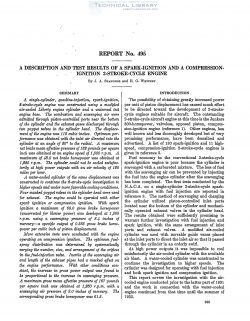naca-report-495

- Version
- 170 Downloads
- 1.52 MB File Size
- 1 File Count
- August 26, 2016 Create Date
- August 26, 2016 Last Updated
National Advisory Committee for Aeronautics, Report - A Description and Test Results of a Spark Ignition and a Compression Ignition 2-Stroke Cycle Engine

A single—cylinder, gasoline-injection, spark-ignition,
8-strolce-cycle engine was constructed using a modified
air-cooled Liberty engine cylinder and a universal test
engine base. The combustion and scavenging air were
admitted through piston-controlled ports near the bottom
of the cylinder and the exhaust gases discharged through
two poppet valves in the cylinder head. The displace—
ment of the engine was 118 cubic inches. Optimum per—
formance was obtained with the inlet air directed into the
cylinder at an angle of 20° to the radial. A maximum
net brake mean efl'ective pressure of 132 pounds per square
inch was obtained at an engine speed of 1,000 r.p.m. A
maximum of 43.0 net brake horsepower was obtained at
1,2:35 r.p.m. The cylinder could not be cooled satisfac-
torily at high power outputs with an air velocity of 120
miles per hour.
A water—cooled cylinder of the same displacement was
constructed to continue the 2-strolee—cycle investigation to
higher speeds and under more favorable cooling conditions.
Four masked poppet valves in the cylinder head were used
for exhaust. The engine could be operated with either
spark ignition or compression ignition. With spark
ignition a marimum cg“ 6.9.0 gross brake horsepower
(uncorrected for blower powa) was developed at 1,800
r.p.m. using a scavenging pressure of 8.4 inches of
mercury—a specific output of 0.585 gross brake horse—
power per cubic inch of piston displacement.
More extensive tests were conducted with the engine
operating on compression ignition The optimum fuel-
spray distribution was determined by systematically
varying the number, size, and arrangement of the orifices
in the fuel-injection valve. Inertia of the scavenging air
amd length of the eahaust pipes had a marked efi’ect on
the engine performance. With other conditions con~
stunt, the increase in gross power output was found to
be proportional to the increase in scavenging pressure.
A maximum gross mean efiective pressure of 167 pounds
per square inch was obtained at 1,230 r.p.m. with a
scavenging air pressure of 8.0 inches of mercury. The
corresponding gross brake horsepower was 61.5.
| File | Action |
|---|---|
| naca-report-495 A Description and Test Results of a Spark Ignition and a Compression Ignition 2-Stroke Cycle Engine.pdf | Download |

Comment On This Post